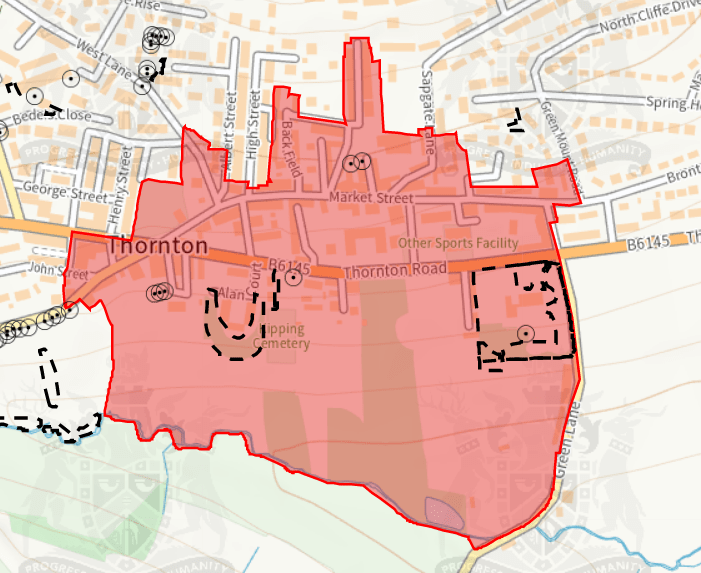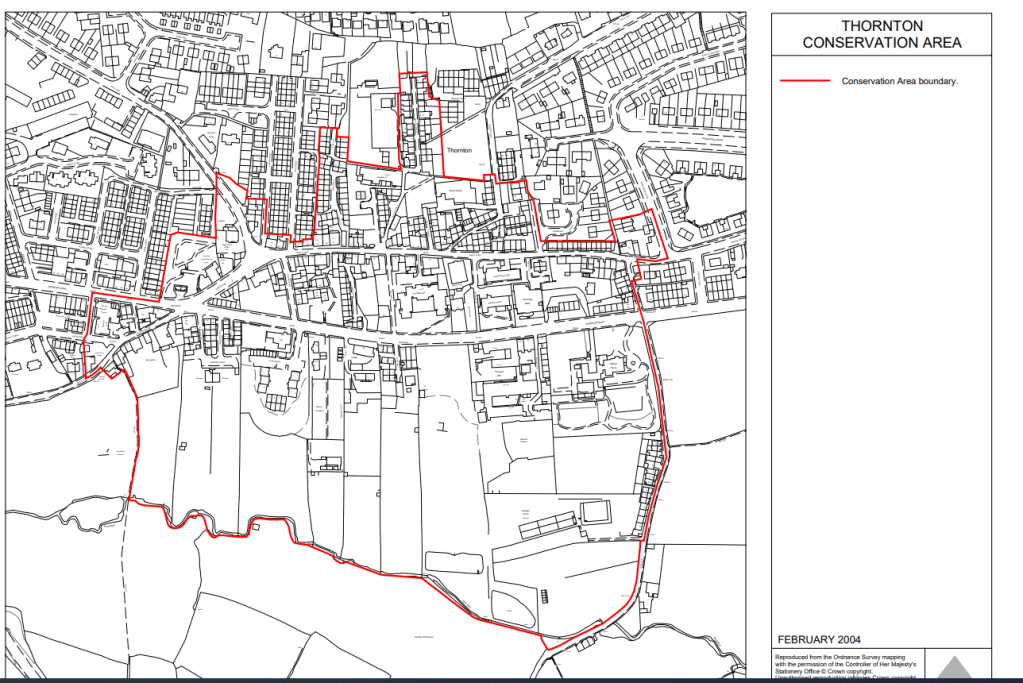
The shaded area is the Conservation Area, taken from Bradford Council’s map which also shows Tree Preservation Orders

The official map of the Conservation Area which can also be viewed on Bradford Council’s website
Bradford Council have produced the Thornton Conservation Area Assessment, and Appraisal documents (pdf format) which can be accessed by clicking on the green links.
Special planning rules exist in Conservation areas, and it is wise to consult the Landscape, Design and Conservation planning officers before you start any development. A “development” can mean even minor changes to buildings and garden trees or boundaries in Conservation Areas.
Guide to Preserving and Enhancing Conservation Areas
Bradford Council have produced an illustrated guide to preserving and enhancing Conservation areas which can be viewed or downloaded in full, or by individual topics, as follows:
- Introduction
- Section 1 – Maintenance, repair and restoration
- Chimneys
- Stone slate roofs
- Slate roofs
- Rainwater goods
- Stone elevations
- Render
- Windows and doors
- External joinery
- Ironwork
- Section 2 – Modernisation
- External features
- Section 3 – Gardens and trees
- Gardens and Trees
- Boundary Walls
- Outbuildings
- Hard Surfaces
- Contacts and further reading
- Contacts and Further Reading
Protected trees in Conservation Areas
Conservation Areas are special areas designated to conserve the districts valuable heritage assets. As well as protecting buildings and other built structures they also protect trees that have a stem diameter which is bigger than 75 mm when measured at a height of 1.5 metres above ground level. The penalties for unauthorised felling or lopping of trees in Conservation Areas are the same as for trees protected by Tree Preservation Order.
Some trees in conservation areas also have a specific Tree Preservation Order attached to them. In these cases the Tree Preservation Order rules apply.
What is a Tree Preservation Order?
Tree Preservation Orders (TPO) are made by the Council to give legal protection to any tree, group of trees or woodlands that make an important contribution to a public amenity.
A Tree Preservation Order makes it illegal to cut down, prune, or otherwise damage a tree protected by a TPO without the council’s consent and the unauthorised lopping or felling of a tree is a criminal offence which can result in an unlimited fine. If a tree is illegally felled to facilitate development then the fine can be raised to the cost of the development value.
Buildings at Risk register
Historic England has put Thornton Conservation Area in its “Buildings at Risk” register. The Condition of the Conservation Area is stated as Very Bad, its Vulnerability is described as Low, and the trend as Deteriorating.
Designation of a conservation area gives broader protection than the listing of individual buildings. All the features, listed or otherwise, within the area, are recognised as part of its character. Conservation area designation is the means of recognising the importance of all these factors and of ensuring that planning decisions address the quality of the landscape in its broadest sense.
The legislation about Conservation Areas is in the Listed Buildings and Conservation Act of 1990, Case Law in respect of Conservation Areas, plus regulations in the National Planning Policy Framework, and Bradford Council’s Planning policies. Section 72 of the 1990 Act states that in considering whether to grant planning permission for development with respect to any buildings or other land in a conservation area, special attention shall be paid to the desirability of preserving or enhancing the character or appearance of that (conservation) area
Estate agents appear poor at informing future buyers that a property is in a designated conservation area, and that property owners have a custodian role, ensuring that planning permission is sought for any changes to a building, or tree, in a conservation area.
Last updated 7 June 2023